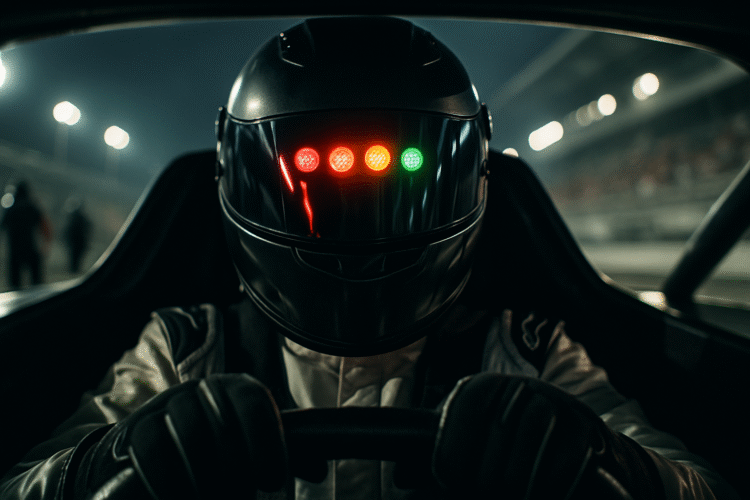Racer Techniques to Achieve Peak Focus

Your visor fogs with breath as the start lights blink red. The world shrinks to the asphalt ribbon ahead, with engine notes melting into white noise. In this “tunnel,” every braking point appears at exactly the right moment, and your hands seem to steer on autopilot. That razor-edged clarity racers chase on track is called a flow state, and the same mental gear can supercharge your workouts and workdays.
What Is a Flow State?
Psychologist Mihaly Csikszentmihalyi coined the term “flow” after studying elite performers across various fields. [a]He identified key components like clear goals, deep concentration, and a balance between skill and challenge. This alignment allows your brain’s prefrontal cortex to downshift, letting you act faster than you can think.
Performance-enhancing neurochemicals sharpen focus and accelerate pattern recognition, creating a feeling of effortless action where you lose track of time. Studies confirm this, showing that winning athletes score significantly higher on flow dimensions like having a sense of control. Interestingly, research also indicates that cultural background can influence flow scores, suggesting the experience can vary across populations.
Signs you’re in flow:
- You lose track of time.
- Actions feel automatic yet precise.
- Self-doubt disappears until the task ends.
| Key Insight: Flow isn’t magic; it’s your brain strategically quieting its overthinking prefrontal cortex, allowing your instincts and honed skills to take the lead with maximum efficiency. |
Throttle & Thought: How Racers Enter Flow
Top-tier drivers cultivate this mental state with rigorous discipline. Lewis Hamilton often completes a silent visualization lap in the garage before he even straps into the car. MotoGP phenom Marc Márquez pairs that mental rehearsal with rhythmic belly breathing to consciously lower his heart rate, calming his nervous system.
Common pre-race triggers include:
- Visualization of perfect laps, corner by corner.
- Box-breathing techniques (e.g., a four-second inhale, hold, exhale, and hold).
- Physical cues like tightening gloves or a final visor tap, which are tiny anchors that signal the brain it’s time to perform.
| Pro Tip: Elite performers don’t wait for focus; they trigger it. By creating a consistent pre-task ritual, you signal to your brain that it’s time to enter the zone, just like a racer tightening their gloves. |
Neurochemistry of Speed & Focus
The connection between high-speed performance and brain chemistry is profound. One study found that motorcycle riders released a surge of dopamine 15 percent above baseline during high-g turns. This dopamine spike heightens motivation, while the release of norepinephrine sharpens attention to a razor’s edge.
Endorphins also add a mild euphoria[b] that masks physical fatigue, buying racers critical milliseconds of reaction time. While high velocity is a natural trigger, you can mimic it with deliberate practice or specific music tempos.
For those exploring other methods to enhance focus, it’s essential to research thoroughly. The Kratom Connection’s guide on where to buy Kratom, for instance, can provide information on plant-based options.
| Key Insight: High-stakes performance creates a potent neurochemical cocktail. The dopamine for motivation, norepinephrine for sharp focus, and endorphins to mask fatigue work in concert to unlock peak human potential. |
Translating Track Techniques to Everyday Wellness

Alt text: Calmness through mindfulness in both racing and business settings.
If achieving a flow state feels unattainable outside of a race car, think again. The core principles are universal and have proven benefits in decision-making and mental well-being. Your “cockpit” might be a desk or yoga mat, but the mental mechanics remain identical.
| Racing Ritual | Why It Works | Daily Equivalent |
| Pre-lap box breathing | Lowers cortisol; steadies heart rate | A 60-second breath drill before a job interview |
| Visualizing apexes | Primes the motor cortex for precision | Mentally rehearsing a slide deck before hitting “Share Screen” |
| Tightening race gloves | A physical anchor to signal go-time | Slipping on noise-canceling headphones to start a deep-work sprint |
| Cool-down lap debrief | Immediate feedback cements learning | A 5-minute journal entry after a workout |
Practical Exercises to Cultivate Flow
A. Structured Pre-Task Routine (2–3 minutes)
Follow these simple steps to build your own focus-triggering ritual:
- Choose one physical anchor, such as sipping mint tea or tightening your shoelaces.
- Pair it with two complete box-breathing cycles (inhale-hold-exhale-hold).
- Visualize only the first actionable step of your task, not the entire project.
B. 90-Minute Deep-Work Sprint (“Quali Session”)
Cognitive output spikes when you block out approximately 90 undisturbed minutes. Mute your phone, close all unrelated tabs, and consider starting a playlist with a tempo around 140 BPM to mimic the elevated heart rate drivers feel on the starting grid.
C. Sensory Immersion & Environmental Cues
Create context-based memory traces that trigger focus upon arrival. This could mean dimming the lights for a specific task, using a single essential oil scent for your workspace, or finding a local café dedicated solely to deep work.
D. Mindful Cool-Down / Reflection Lap (5 minutes)
Immediately after completing a task, jot down two small victories and one potential area for improvement. This immediate feedback loop is identical to racers reviewing telemetry data with their engineers before leaving the pit lane.
Pitfalls & Misfires: When Flow Eludes Even Pros
It is important to distinguish flow from its counterfeit cousin: burnout. Burnout can mimic flow’s hyper-focus but leaves you feeling drained and depleted rather than energized. Mental overstimulation from constant notifications is a common barrier, preventing your brain from finding that optimal sweet spot. If you feel distraction creeping in, reset with a short walk or a simple breathing drill.
| Important: Be mindful of the difference between flow and burnout. True flow state energizes you, while burnout’s hyper-focus is driven by stress and leaves you feeling completely drained and depleted afterward. |
Final Lap
Flow is a state where skill and challenge align, flooding the brain with performance-enhancing chemicals. Racers cultivate flow using visualization and breath control, which are all strategies you can adopt for daily tasks. By creating simple routines and managing your environment, you can nudge your brain toward its optimal state of focus.
[a]Fact checked: https://pmc.ncbi.nlm.nih.gov/articles/PMC10204032/
[b]Fact checked: https://my.clevelandclinic.org/health/body/23040-endorphins
Read more on
MyCarHeaven are on Instagram. Go check us out and do follow us.
Go visit the MyCarHeaven Instagram page. We post regular quality content, predominantly focused on classic cars, supercars, hypercars and car shows. We also feature all our competitions here, where you will have the chance IF YOU FOLLOW US and you follow the competition entry criteria, you could be in with a chance of winning tickets to the best UK car shows, and other automotive stuff.
Go to the MyCarHeaven Instagram account here. Advertisement
Advertisement Advertisement
Advertisement Advertisement
Advertisement Advertisement
Advertisement




